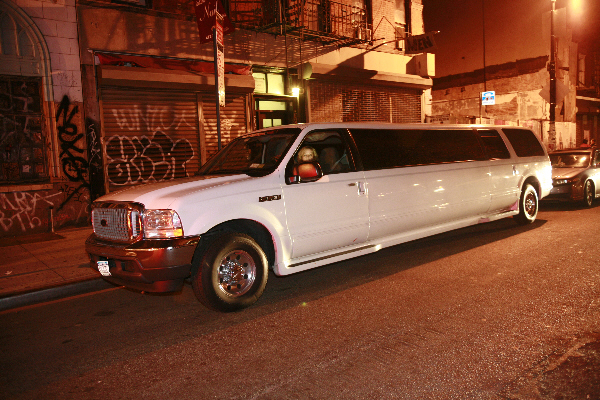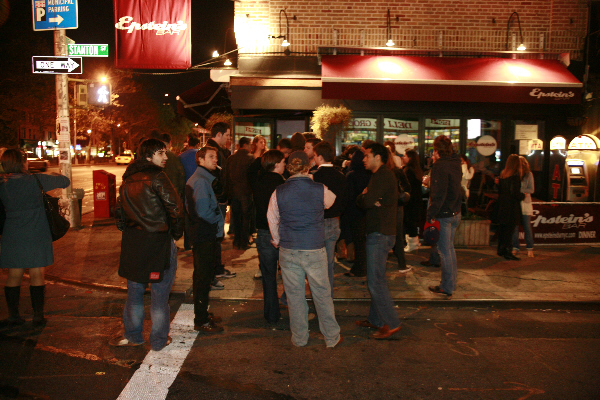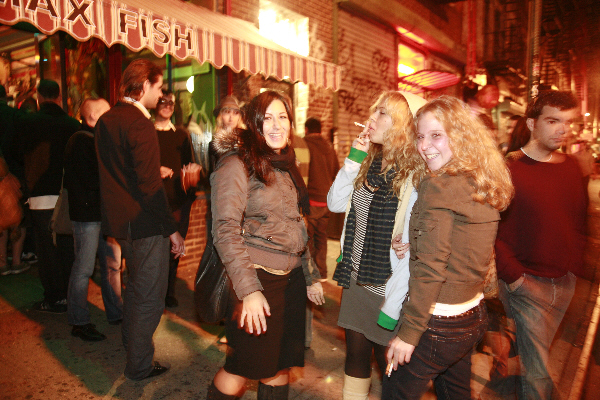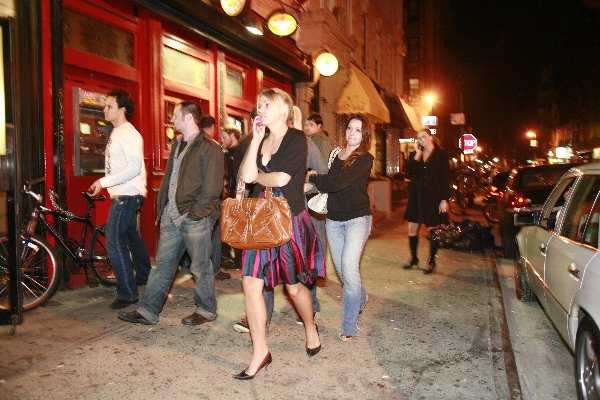Allegro
Turning the Tide
Supporting Musicians by Grasping the Power of the Liquor License
Volume CVII, No. 12December, 2007
|
THE NEW GENTRIFICATION: Images of the new Lower East Side, by Clarke Harstern. A proliferation of bars has meant that the neighborhood has turned into a miniature Times Square. But more bars has not meant more venues for live music. Can Local 802 have a say in improving conditions for both community members and musicians by influencing the process of liquor licensing? |
||
What if we could improve conditions for musicians in New York City by stepping in at the point where liquor licenses are given out?
This is an idea that came to me after spending several years working with neighbors trying to prevent my neighborhood – the Lower East Side – from being remodeled into an increasingly upscale tourist drinking zone.
In learning about the State Liquor Authority – the agency that grants venues the right to sell alcohol – and its singular and devastating effect on our community, I have tried to figure out how involvement with it could actually help the union bargain on behalf of musicians.
Because it was at first believed that this new bar rush might provide gigs for musicians and artists – and be a part of some bohemian movement – I felt at first some inner conflict. How could I stand with neighbors to deal with this problem, yet support my fellow musicians at the same time?
Over the years, I learned the ins and outs of liquor licensing. And in the process, I may have stumbled upon an idea, a focal point where musicians and Local 802 might be able to improve conditions for musicians – and even residents. More on this later. First some background.
LEGENDARY HISTORY
The Lower East Side landscape was always dotted with amazing music, art and performance spaces.
There were legendary places like King Tut’s Wah Wah Hut, stalwarts like CBGB’s, venues like Brownies and Fez, places where local salsa bands or experimental musicians played, music rehearsal buildings – all breeding grounds for renegade talent, and all now gone.
The venues were not merely drinking holes but homes to incredible, innovative and very counter-cultural performers and musicians.
Artists who could not get gigs in mainstream clubs could find a home in the scattered and hidden gems of the Lower East Side. Hence, a lot of world-famous music and art was born here.
The earlier scenes were seen as bringing creative freedom and vibrancy to a much neglected, depressed area. I myself can remember when I was a kid going down a block of boarded up and bombed-out buildings to get to a community performance space in an abandoned building that, once entered, was like a magical world of Christmas lights, cardboard backdrops and live music playing, the likes of which I had never heard on the radio.
But this smaller, locally-nurtured creative scene opened a Pandora’s Box no one could see coming.
It took some time, but landlords learned that a certain crowd was willing to brave the then-edgy streets to get to these cultural spaces. Clubs started opening that were larger and larger.
Since then, mainly in the last eight years, the neighborhood has literally exploded and become filled with increasingly upscale bars and clubs.
Huge hotels started appearing to capitalize on this new scene, aimed at a transient tourist population.
Rents skyrocketed as landlords realized they could get more from these hip drinking holes than from a tailor, community dental clinic, family-owned bodega, small collective art gallery or experimental music space.
Just as equally sinister, landlords also realized that by putting a bar or club on the ground floor of a tenement, they had a new way to harass tenants out of their longtime, rent-stabilized apartments.
|
KEEP CULTURE ALIVE One theme of Rebecca Moore’s story on these pages is that high rents and bar proliferation are pushing out authentic cultural spaces. Moore was arrested earlier this year while protesting the closing of Tonic, the Lower East Side’s last large venue for experimental music. The protest and subsequent press conference attracted the support of City Councilmember Alan Gerson, who represents the Lower East Side. He says he will propose legislation that would provide property tax abatements for music venues. Allegro will keep readers updated on Gerson’s legislation. For the latest news, contact Local 802’s political director at (212) 245-4802, ext. 176. |
CULTURAL BULLDOZER
While the Lower East Side had seen a lot of hard times in the past, my neighbors – who had embraced the more gritty years – despaired that the new situation was out of control, forcing out everything in its path and creating a sort of cultural genocide for much of the immigrant and various alternative communities that had deep roots here.
Where once there had been inspiring landmarks of community self-
initiative and empowerment, now – blooming like weeds – sprung a one-note nighttime economy: that which funded the SLA, real estate development, and nothing else.
Ironically, the classic Lower East Side venues, which had been here decades before the money-spending masses dared set foot, were themselves forced out in the deluge, victims of the very spark they had unwittingly ignited.
While some in local politics tout it all as a booming economy, many of us can’t help but feel the changes do not benefit those who have contributed huge portions of their lives here. The new bars get more and more expensive and upscale, yet seem to be less and less about live music or any culture – certainly not local culture.
If, on rare occasion, a new venue opens that does feature live music, it tends to book huge numbers of bands per night (eight to ten or more), creating worsening gig conditions.
Some are even charging for soundchecks to cover their own rising costs – like the Living Room on Ludlow Street, which charges up to $40.
If a new place does open as a supposed live music venue, it’s usually designed so that the space allotted for music is tiny and the spaces allotted for drinking and eating are massive.
It’s clear that the bar explosion is not trickling down to benefit many musicians or artists. The number of live music spaces is dwindling, and they are moving further and further out towards the city’s boundaries.
LEARNING THE ROPES
Over the course of several years I attended an exhausting number of community board meetings, got to know and worked with community activists, researched the State Liquor Authority, and followed test cases to learn the very fuzzy liquor license process.
One big part of the problem was that the SLA did not seem to enforce its “500-foot rule” in every neighborhood the same way, despite the efforts of residents to have it enforced.
The rule basically says that if there are already three bars within 500 feet of each other, a fourth cannot open without a public hearing – and it must prove it would be of community benefit. This is supposed to protect communities from – well, what was happening to us.
The 500-foot rule was clearly being enforced in wealthier neighborhoods where residents had lawyers to protect their interests and quality of life. But on Orchard Street and all over the Lower East Side, we had no voice whatsoever.
Another big problem was that even though the community board is the group that votes and makes decisions based on community concerns, its votes against a liquor license do not actually hold any weight.
Residents and families wait patiently four to six hours at community board meetings for the chance to speak. But it is a black hole, because the liquor authority considers community board resolutions to be “advisory” only. Even if the board decided to deny a liquor license, a few weeks later that bar was open for business anyway.
SIGNS OF HOPE
In 2005, I worked with activists and organizers, block associations and community groups, to come together. We threw our own, huge grassroots town hall meeting at the Angel Orensanz Foundation on Norfolk Street. Our own community board declined to support us or take part in the meeting. (It turns out that our community board chairman owns many bars in the neighborhood!)
Over 300 people came out to finally talk about what was going on in the neighborhood.
The issue was suddenly out of its silent stranglehold and put into a larger spotlight. Newspapers and magazines covered it.
There were some hysterical headlines, but it was a beginning: discrepancies were being exposed. The real dialogue began.
In the months that followed, the head of the State Liquor Authority stepped down in embarrassment. (He was under separate investigation by then District Attorney Eliot Spitzer’s office for a related scandal.)
The SLA next declared a “temporary moratorium” on licenses until it could present to the public a more transparent, clearly-defined set of protocols, which it eventually did. (One of these new protocols was simply about posting information about hearings publicly – online – where all could read them.) It also announced profound shifts in agency procedures, such as giving community board votes more weight.
A DIFFERENT ANGLE
According to tour guides, politicians and the police, the Lower East Side is now a “nightlife district.” I can’t see my neighborhood going back to being the quiet, affordable, community that it was – though I will probably continue working on these issues. So if that’s the case – and if I am going to be kept up until 4 a.m. every night – I would rather it be because there are musical artists out there being treated well and having better places to gig.
It’s occurred to me that Local 802 might be able to make this happen. Here is how I think it’s possible.
What if the union were a presence at community board meetings?
What if, when a new bar wants to apply for a liquor license, it has to sign an agreement with Local 802 guaranteeing that it will provide a space for live musicians to play under fair terms and conditions? There would also be stipulations that would advocate for nearby residents.
At this stage of things, getting and keeping a liquor license on the Lower East Side has higher stakes now. This is because the liquor authority has created such a packed situation. We are actually running out of room for new licenses.
Because of how hard it is to squeeze another bar into our streets, venues applying for liquor licenses – and those renewing – are forced to show community support. They must do what they can – via letters, petitions and testimony – to argue successfully that they are of some kind of benefit to the neighborhood.
Local 802 should be positioning representatives at community board meetings around the city: The union’s presence could have significance and carry weight.
At these meetings, Local 802 could say, “We’ll give official support of your venue as a place of cultural and community enrichment, if you agree – in writing – to book live musicians under fair and just conditions.”
These conditions could include a number of things: a fair cut of the door or a guaranteed scale, access to a dressing room, food for the musicians, a fair drink policy, etc.
This, combined with City Councilmember Alan Gerson’s proposed tax-abatement legislation for small music spaces, could encourage more places to become live music venues that otherwise might have just become another generic sports or wine bar.
The union’s involvement could also be important if a previously “bad” music club owner – such as the 169 Bar, discussed in the October issue of Allegro – needed to renew its license. That is, if the venue was on record mistreating musicians, Local 802 could testify against that license being renewed unless the owner agreed to improve conditions.
And Local 802 could score points with the neighbors and community by incorporating into the agreement noise reduction specifications, such as soundproofing measures or simply a policy of keeping the front doors of the venue closed.
This could help reduce the backlash so many musicians and music venues face in today’s increasingly-crowded environment where music spaces have to co-exist with more and more residential sprawl.
To sum it up, Local 802 could really effect change, by becoming a part of the process, being a necessary link in the chain at the ground level where a music venue is born.
(One important footnote: venues that are not-for-profits would have to be exempt from this completely or receive support from the union based on their mission statements.)
Finally, monitoring and enforcing of any club could be done via an online poll where musicians could rate the conditions of various factors at each club they played. (See italicized note at bottom of page 12.)
WE’RE IN IT TOGETHER
New York City claims it wants to support live music and vibrant culture here, despite it looking more and more like a sea of Starbucks, Duane Reades, and sterile glass condos.
The city prides itself on attracting tourists – particularly via its once legendary, exploding live music scene. But that scene faces extinction as the spaces close and affordable artist housing also disappears.
The city is perched on a dramatic new cliff, where it runs the risk of becoming a gated and barren community.
I think Local 802 should go right to the pressure point.
If the union can work with community activists to create a larger voice of leverage when venues apply for liquor licenses, everyone can win – both musicians and the community.
Right now, musicians ask club owners: “Can I have the privilege of playing in your club, where you make money by selling my audience drinks?”
It should be the other way around: “You – the club owner- get the privilege of having a liquor license, in exchange for supporting local culture and musicians and by keeping something important – live musical energy – in the New York community.”
Local 802 member Rebecca Moore is a musician, singer and recording artist; information about her music can be found at www.Bluviolin.com. She was recently featured in the June 2007 issue of Allegro when she was arrested protesting the closing of Tonic. Her last story for Allegro was in February 2005 when she wrote about the two-year fight to win Knitting Factory recording artists the rights back to their work. She is co-founder (with Norman Yamada) of www.TakeItToTheBridge.com, an online organizing hub for musicians that was central in both the Tonic and Knitting Factor actions. The site hopes to put in place an online club rating poll in the coming year.




